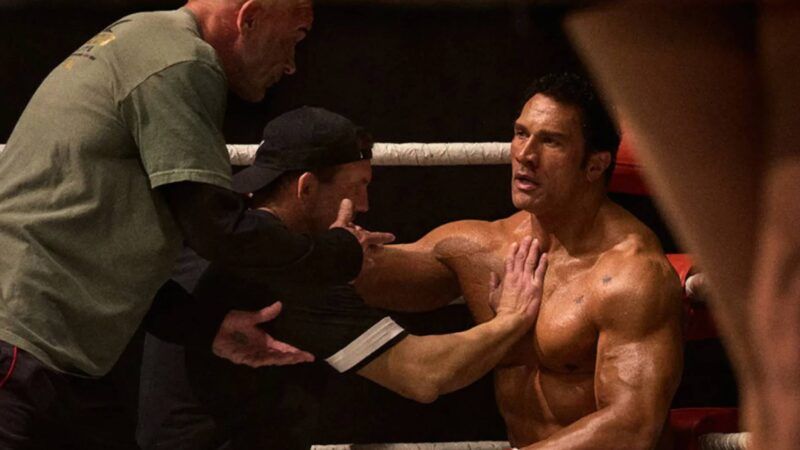The Smashing Machine Looks at the Early Days of a Combat Sport Politicians Wanted To Ban
A fascinating but uneven actor's showcase for Dwayne Johnson.

It's easy to forget, in today's world of UFC superstars, that in the early days of mixed martial arts there was a push from politicians to ban the sport. In the 1990s, Sen. John McCain (R–Ariz.) called it "human cockfighting," The New York Times editorial board called for the banning of its "extreme barbarism," and the state of New York even went so far as to enact a prohibition. This sort of no-limits combat, the argument went, was not a civilized form of sport or entertainment. It was just brutality.
Efforts to ban the UFC are only briefly mentioned in The Smashing Machine, the new movie about Mark Kerr, one of the sport's early pioneers. But the brutality is front and center. In the ring, Kerr demolishes his opponents, grappling them to the floor, pinning them down, and then pounding them into submission. The movie's title is his nickname, the man he became in the ring. But the point it tries to make, with varying degrees of success, is that there was no way to completely confine that brutality to the ring.
Played by wrestler and actor Dwayne Johnson, better known as The Rock, The Smashing Machine is a character study of Kerr, a film about the connection between the body and the mind, life and work, and the fight to survive both in the ring and outside of it.
When he's not beating people to a pulp, Kerr is gentle and soft-spoken, a teddy bear of a man despite his massive size and bearing. He's sweet with old ladies and thoughtful with reporters, calmly—almost gently—explaining how he plans to demolish his opponents. Yet he's demolishing himself.
When the movie starts, he's addicted to painkillers. The opioids reduce his physical pain, but there's also a suggestion that they reduce mental anguish—at least some of which stems from his rocky relationship with his girlfriend, Dawn (Emily Blunt). The movie never quite seems sure whether Dawn is a villain, a selfish and malignant force in Kerr's life, or whether she's a victim, stuck in a strange relationship with a dangerous man who constantly picks at her and occasionally tears a door off its hinges during arguments. That might stem from the impenetrability of human relationships themselves—fair enough. But at times, it plays more like the filmmakers simply don't know what to make of her.
Kerr is far more fully realized, thanks in part to Johnson's physical transformation. In a hairpiece and facial prosthetics, the star is nearly unrecognizable, and the performance has nothing of the lock-jawed, bordering-on-camp action-star bravado he so often brings to roles. If nothing else, The Smashing Machine is a reminder that Johnson—who has gravitated toward generic star vehicles that showcase his bulk more than his performing chops—is, in fact, a remarkable screen actor, capable of a kind of nuance and psychological complexity that he rarely shows.
But as remarkable as that performance is, it can't quite make the film whole. Director Benny Safdie relies on a choppy narrative structure, in which scenes feel disconnected from one another. This structure manages to avoid some (though not all) biopic clichés, but the movie never quite seems to know why any given scene flows from the next.
It's an uneven film that never quite seems to decide what it's about. A coda suggests it wants to be a story about the rise of combat sports, and the way early fighters like Kerr paved the way. Today, superstar fighters like Conor McGregor can earn tens of millions of dollars, whereas the final tournament in The Smashing Machine offers a reward of just $200,000—an amount the movie repeatedly insists is "life-changing." One reason the sport survived its early political battles is that it became too popular to ban. And as its audience grew, a modicum of respectability followed.
At times, the movie seems to suggest that it wants to be about losing, about failure, about what happens when bodies age and the high of victory is no longer available. But it can't quite connect the threads to fully land this theme either. So Safdie relies on Johnson's striking, subtle performance to carry the film, acting as its through-line and center of gravity. He's the machine that makes this scattered movie run—and he smashes it.
